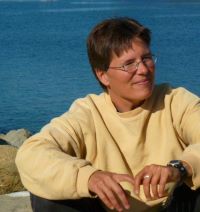May 8, 2019
“Under what circumstances does science help inform policy?”
Posted by Sharon Rauch
 Career arc: Susanne Moser has never constrained herself to just one field. During her training, she started out in physical geography, a field that incorporates “all flavors of geoscience, even humanities,” then moved into human geography, which gave her a great foundation for examining the million-dollar question: Under what circumstances does science help inform policy?
Career arc: Susanne Moser has never constrained herself to just one field. During her training, she started out in physical geography, a field that incorporates “all flavors of geoscience, even humanities,” then moved into human geography, which gave her a great foundation for examining the million-dollar question: Under what circumstances does science help inform policy?
She’s carried that question with her throughout her career, which has focused much on adaptation to climate change. After a position at the Union of Concerned Sciences, where she learned the “skill and art” of strategically translating science to policy, Moser moved to the National Center for Atmospheric Research, where she turned her science communication skills into a career-changing focus on researching climate change communication.
Moser then took a leap from institutional employment to starting her own business as an independent researcher and consultant. While she says the move was definitely a career risk, it proved to be one worth taking. Today, she provides research and advice to advance adaptation goals at multiple levels, often serving as a bridge among municipalities, states and federal agencies and other stakeholders.
Given the climate challenges faced by communities all over the world, she sees her work as part of a broader responsibility to give climate adaptation the all-hands-on-deck attention it deserves.
“To me, it would be a luxury to do science that doesn’t inform something, while we’re in the middle of an existential crisis like climate change.”
Motivation: Building partnerships is what drives success in Moser’s business. She says it is impossible to overstate the importance of understanding and respecting everyone’s role and special expertise—a lesson that carries through to virtually any situation involving multiple stakeholders. For informing climate adaptation efforts, it’s critical to first understand what the community’s true needs are, know where the power and influence lies, and establish a process that allows involved parties to co-design research questions as well as planning and decision-making processes.
Instead of just delivering a report and expecting clients to connect the dots themselves, Moser has also learned to communicate how to use the information so that it is interpreted appropriately and put to use more effectively.
“Engaged science to me means you enter into a partnership with the people who ultimately want to use the scientific information, in order to truly understand what they need.”
How I see community science: For someone focused on translating science into informed decision making, there is tremendous value in engaged science (Moser’s preferred term for the collaborative approach AGU calls community science). She notes there is a growing push for this approach, particularly on the part of communities, but that barriers remain, especially in academia where change is slow. In her view, academics still tend to take a conservative approach to science, with engaged science often perceived as second-tier and less prestigious.
Moser sees promise in the work of “boundary” organizations like AGU’s Thriving Earth Exchange and Stanford University’s Leopold Leadership Program, which partner with universities to enhance engaged science practice and training. But she hopes for a day when this training is included within graduate education, rather than being tacked on or cobbled together later in researchers’ careers.
“There are still obstacles stacked against this field. Tenure is based on publications, not how many city council meetings you’ve been to. We need to move from tolerating engaged science to promoting it.”
 Looking ahead: While significant gaps remain—between science and engineering, and between scientists and policy makers, to name a few—Moser sees a renewed interest in bridging those gaps. A lot of this is driven by the stark reality of the challenges that lie ahead, and the clear need for science to play a role in informing how we respond. The desire for reliable, actionable information on climate adaptation should keep Moser—and lots of others—busy for years to come.
Looking ahead: While significant gaps remain—between science and engineering, and between scientists and policy makers, to name a few—Moser sees a renewed interest in bridging those gaps. A lot of this is driven by the stark reality of the challenges that lie ahead, and the clear need for science to play a role in informing how we respond. The desire for reliable, actionable information on climate adaptation should keep Moser—and lots of others—busy for years to come.
“I think there is a growing demand for engagement with science. That has a lot to do with working in climate change, where everyone looks to science to tell us what will happen.”
Ultimately, she believes, engaged science will change the scientists and the practitioners involved. She argues that change is needed on both sides.
“If you choose to do this, not just once, but in a committed fashion for years, and you are reflective and open to learning from the process, trust me, you won’t stay the same. Nor do your partners. I am so grateful for what I’m learning and how I’m growing not just as a researcher, but as a person.”
Susanne Moser, Director, Susanne Moser Research and Consulting


 On the Job is an AGU blog, that provides career advice and workforce guidance to geoscience students, early-career and established professionals who are interested in pursuing professional enrichment.
On the Job is an AGU blog, that provides career advice and workforce guidance to geoscience students, early-career and established professionals who are interested in pursuing professional enrichment.